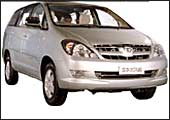 |
| RBI Governor Y.V. Reddy: Keep speculators
off realty |
The
astronomical rise in Mumbai's real estate prices following the
sale of textile mill lands caught most people by surprise-including,
as it turns out, the central bank. In a move that can be linked
to this, the Reserve Bank of India (RBI) has decided to increase
the risk weightage to lending to (this applies to residential
and commerial) real estate developers, thereby ensuring that speculation
isn't fuelled by easy money.
For a while now, real estate consultants
have spoken of how the current increase in prices-this touched
Rs 15,000 per square foot in August in the case of Kohinoor Mills,
compared to the sale of Jupiter Mills property, which fetched
Rs 4,000 a square foot in May-is completely unsustainable and
that developers will find it very difficult to recover their investments.
While Colliers Jardine CEO, Akshaya Kumar, thinks that there is
a lot of potential in the overall real estate business, he maintains
that the caution from a lending point of view is welcome. "However,
what is required is a project-specific approach," he says.
Banks, quite obviously, have been affected by the RBI move and
admit that their business will be impacted. "A 25 per cent
risk weightage of this kind will definitely impact our business.
We are still awaiting details on the directive," says Punjab
National Bank's Executive Director, C.P. Swarnkar. In his words,
the decision is right and there is nothing unrealistic about it.
Most players in the industry admit that the objective behind the
decision is to end the high levels of speculation and to bring
in more sense into the business.
Those like the ICICI Bank, by virtue of having
limited exposure to commercial real estate business, say they
will be not be greatly affected. As ICICI Bank Executive Director,
Chanda Kochhar, puts it, "Our exposure to commercial real
estate business is around 3 per cent of the total loans and advances
because of which the impact would not be significant and is expected
to be in the range of 7-8 basis points on capital adequacy."
Clearly, lesser money to fund the commercial real estate boom
would have some impact on the market. But just how it will play
out isn't easy to say at this time.
-Krishna Gopalan
UPGRADE
Missing The Qualis?
When
Toyota Kirloskar motor pulled the plug on its 20-year-old workhorse,
the Qualis, and replaced it with the Innova, many in the auto
industry thought that the Japanese giant was making a mistake.
Guess what? They were wrong and Toyota was right again (it had
been warned against launching Qualis, which eventually sold more
than 100,000 units). The multi-utility vehicle (MUV), Innova,
has been rolling off the showrooms faster than the Qualis (see
Better, All the Way). While the Qualis sold 6,630 units in the
first five months of its launch, the Innova did 17,960 in the
same period. Now, of course, all eyes will be on the small car
that Toyota has promised to launch in India. "We are still deciding
which model to bring in, but rest assured, Toyota will have a
small car in India soon," the company's India boss, Atsushi Toyoshima
told reporters while introducing the Innova's new brand ambassador,
Aamir Khan. Rival car companies must already be sweating.
-Kushan Mitra
Building The Chip Ecosystem
Texas Instruments sees promise in chip manufacturing.
 |
| TI's Engibous: Betting big on India |
In
1985, Texas Instruments (TI) did the unthinkable when it decided
to set up a development centre in Bangalore, which was very much
a pensioner's paradise back then. Two decades on, the American
semiconductor giant is betting on the fact that India could soon
become a powerful chip design-to-manufacturing country. "Electronic
manufacturing has been very small until now. But that's changing,
and today is probably the beginning, evidenced by the commencement
of cell phone-manufacturing than anything else," TI's Chairman,
Thomas J. Engibous told BT on his recent visit. "What will
drive manufacturing is the local consumption of electronics,"
he said.
There's little doubt that the local electronics
market-cell phones at least-is expanding rapidly. According to
industry estimates, there are over a hundred million mobile phone
users in India and this number is increasing by two million every
month. Cheaper handsets and falling usage costs are driving growth
in this market. Motorola, for instance, introduced a phone priced
below Rs 1,500. Driving this revolution further, Engibous says,
TI's single-chip platform for cell phones promises to drive down
costs by as much as 30 per cent.
Two manufacturers, Elcoteq in Bangalore and
Nokia in Tamil Nadu, have already announced investments of up
to $100 million (Rs 440 crore) and Rs 625 crore, respectively,
in manufacturing facilities. Another company, Quasar Innovations,
has tied up with Nasdaq-listed Primus and is pioneering the ODM
(original design maker) concept for cell phone design.
Other pieces of the semiconductor jigsaw
also seem to be falling into place, including a 3.5 lakh sq ft,
Rs 65-crore Semicon Park, which opened in Bangalore a few weeks
ago. "There's no question that the change is already starting.
The unique thing about India is that it is not fascinated by manufacturing
and focuses on IP. This will build more stable companies over
the long haul. That's a huge advantage India has over other the
others," says Engibous.
Looks like despite all the odds, India is
on its way to becoming a semi-conductor hub.
-Rahul Sachitanand
IN PLAY
Big-ticket Deal
 |
| What's cooking? We'll soon find out |
Who'll
end up buying one of India's best-known brands in the travel business?
When BT went to press, there were reports of a number of investors
(including private equity giants Blackstone, Carlyle and India's
ICICI Venture) wooing Thomas Cook India, which has been put in
play by its German parent. At 33 times PE, the Thomas Cook deal
does look expensive. It will cost Rs 640-odd crore to buy the
German parent's 60 per cent stake and another 20 per cent from
the public. By contrast, Thomas Cook India had just Rs 132 crore
in revenues, year ended October 31, 2004. But $150 million (Rs
660 crore) isn't beyond buy-out giants Blackstone or Carlyle,
both of whom are seriously looking at India.
-Amanpreet Singh
SELF WORTH: ATIQ RAZA
Pakistan's Vinod Dham
Atiq Raza was the man behind AMD's K6 and
Athlon chips.
With
Atiq gone, they are giving Intel a licence to print money".
That's how a West Coast analyst described Atiz Raza's exit from
chip-maker AMD in July 1999. And the analyst wasn't exaggerating.
Widely seen as the man who brought manufacturing discipline to
a money-losing company, Raza was expected to succeed AMD's then
CEO Jerry Sanders. Raza was the man who helped the semi-conductor
industry's perpetual also-ran challenge Intel's supremacy in the
chip business with the AMD Athlon, considered by many as technologically
superior to Intel's Pentium III.
But then, the Pakistan-born Raza, who joined
AMD after it acquired his NextGen Inc in January 1996, has always
been some sort of an iconoclast, and not just in the chip industry.
Well before he was forced to leave Pakistan in 1972, Raza, now
Chairman & CEO of Raza Microelectronics, saw himself as a
misfit at St. Anthony's school and Aitchison College, which were
then preserves of the aristocracy. "I just didn't fit into
that set-up. Instead, I found myself exploring the bylanes of
Lahore on my bicycle, and finding new and interesting places in
the old walled city where I lived," recalls Raza.
His random rides and unending hours spent
in his grandmother's library were, however, soon replaced by some
serious academic pursuits as he fuelled his passion for device
physics, by first pursuing a degree in electronics from the University
of London and then a Master's in Material Science and Engineering
from Stanford. He returned to Pakistan in 1972 and worked in the
harsh North West Frontier Province for a few years as an engineer
with Telephone Industries of Pakistan, but intense persecution
saw him return to the US for good.
The rest, as they say, is history. After
10 years of working in various tech companies, Raza joined a start-up,
NextGen Inc., in 1988, and (after quickly rising up the ranks
to become its CEO) sold out eight years later to AMD for $860
million (Rs 3,010 crore then). "The challenge is to create
newer and more efficient technologies that can potentially shift
the balance of power," says the man who was worth over $4
billion (Rs 18,800 crore then) in 2001. Raza may do so one more
time with Raza Microelectronics.
-Rahul Sachitanand
RIGMAROLE
Waiting To Take Off

Indian
airlines' jinxed fleet expansion plan, first proposed a decade
ago and finally approved after a fashion in March 2002, hobbled
a step closer to realisation. After some Members of Parliament
grounded the plan in May by questioning the Rs 10,237 crore deal
price (the national carrier, they alleged, was paying more for
the Airbus aircraft than others like Malaysian Airlines), the
files have been moved up to the Cabinet Committee for Economic
Affairs (CCEA), following a clearance by the Union aviation minister,
Praful Patel. "This order will allow us to compete more effectively
with the private carriers," says a senior Indian Airlines
official. Delay in order placement, however, will mean delays
in delivery. "Indian Airlines is a valued customer and we
will try and give the best delivery dates possible," says
David Velupillai, spokesperson for Airbus, which must still be
keeping its fingers crossed.
-Kushan Mitra
|










